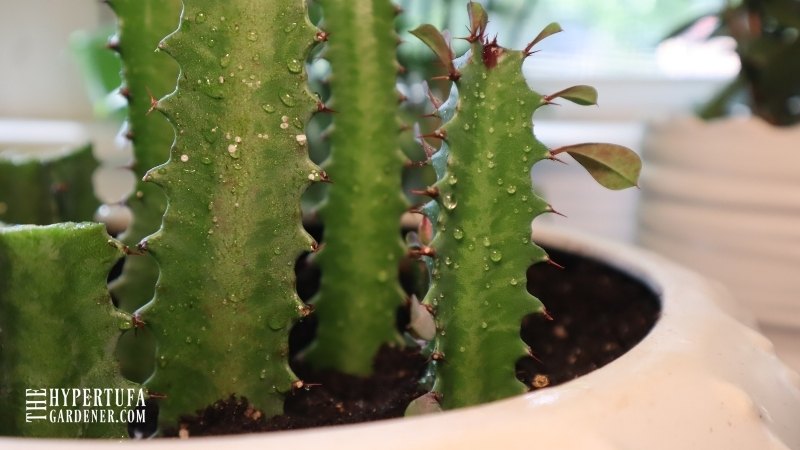African Milk Tree Too Tall- Time To Propagate -Making A Forest
Provide a complete liquid fertilizer diluted to a ¼ strength every two weeks during the plant’s active growth period.
African Milk Tree
These fiery cactus columns are living glowing beacons, directing you in the right direction — to living on “easy street” with indoor plants! These low-maintenance drought-loving Euphorbias need very little water, and a lot of indirect light to prosper and grow. African Milk Tree ‘Rubra’ produces maroon tinged leaves between its spines tall along the stems. Cold temperatures and relocating established plants may cause their leaves to drop. New leaves will re-grow once you have found a permanent place with ample sunlight (more than 6 hours a day!)
Light
As Euphorbia Trigona Rubra are not genuine cacti, extreme sun exposure won’t be tolerated by this indoor plant! As these plants are rooted back in Central Africa, they can deal with and adapt to the sun and heat. These plants love lots of bright light. However, even a couple of hours of sunlight will suffice but lower light levels will slow down their growth. If you find that the leaves are growing on only one side of the plant and the plant starts to lean, it is time to bring it closer to the light source! Rotate your African Milk Tree every month to keep its shape balanced and to prevent it from toppling over.
Water
African Milk Tree Rubra is more often mistaken as a cactus, which results in the mistreatment of the plant, like exposing it to too much direct light and giving it less water than it needs! Though the plant has capability of tolerate drought, they do much better when watered regularly, especially during the warmer months. Water the soil when it has completely dried out. It is fine to miss a few days to a week, but never let the soil get so dry that it becomes hard and impenetrable.
Temperature
Although these indoor plants crave warmer temperatures, they can cope with cool temperatures. Try not to expose them to temperatures below 40°F as they will lose their leaves and their vibrant coloring! The good news is that their leaves will grow back once they are warm and comfortable.
Humidity
If the air circulation is good, then any humidity in any standard home is a good fit for these plants.
Fertilizer
Provide a complete liquid fertilizer diluted to a ¼ strength every two weeks during the plant’s active growth period.
Growth Rate
African Milk Tree ‘Rubra’ lives quite a long time like cacti. They can grow up to 8’+ indoor when giving the optimal growing conditions!
Pet Friend or Foe
These plants aren’t toxic, but pets or children can get hurt by sharp spines if they touch them. Foe-ish!
Pro Tips
- To bring these indoor plants outside for the summer acclimate them to the sun by exposing them to it gradually for 2 weeks. Start out placing them in the shade, then place them in the sun for a few hours a day until they have adjusted to the direct sun exposure!
- Try to plant them in a heavy container. Otherwise, their top becomes heavy while growing tall, and a wind blow can continuously make them fall on the floor. Try Terracotta pots or heavyweight ceramic to keep them standing up-right.
- Use cactus soil when you carefully transplant your African Milk Tree!
African Milk Tree Too Tall- Time To Propagate -Making A Forest

I sure can’t complain when one of our houseplants gets too large. That is a wonderful thing to have to deal with, isn’t it? But right now, my daughter has a 3-foot tall African Milk Tree or Euphorbia trigona and it’s time to propagate!

We have had this Euphorbia since Spring of 2019 and it certainly has grown. But now it needs to be propagated before the long and thin branches are accidentally broken. Side eye to my daughter’s new kittens.

I have more information on the African Milk Tree in a couple of posts here on the site. Be sure to check them out. https://www.thehypertufagardener.com/african-milk-tree-care/ and also Growing African Milk Tree https://www.thehypertufagardener.com/growing-african-milk-tree/
Cautions With African Milk Tree
Of course, the first things that one would see when looking at this plant are its Wicked Thorns. And these are not friendly thorns. They hurt. So be ready with gloves to protect yourself.

As all euphorbias do, these plants have a toxic sap that will run when they are cut or pierced. This sap can irritate your skin and really be painful to your eyes. Be careful with this plant around children and animals.
Quite a bit of sap poured from the stems as we cut them. You can see that in the video.

Choosing a New Pot for Our African Milk Tree
We chose a larger pot since we planned for the propagation to be for multiple stems. As it turned out, we cut nine new pieces to root so hopefully we’ll have a “candelabra’ form. These succulents are sometimes called Candelabra Cactus.
The new pot will be heavier and a wider base to offset any tipping tendencies as our Euphorbia develops its many extensions. It can get top heavy!

Choose a pot deep enough to bury the cut ends about one inch deep. Be sure to keep track of the bottom and top of the cutting so that you can be sure to plant the bottom into the soil. That’s where new roots will form.
Fill the pot with good cactus/succulent soil that is well draining. As for all succulents, good drainage is essential. Use a clean knife or cutting tool to make smooth cuts. Don’t smash the stem as you cut it.

We allowed our cuttings to dry for 6-8 hours but needed to get them planted. Allow yours to dry overnight or several days. Adjust your first watering to fit how long they dried/calloused. Shorter period means little to know water for the first 3-5 days.
If you allow them to callous for a week or more, then water in as you would any plant.

Keep plant in bright light for up to six hours a day and water only after the soil is dry. Be sure to turn the plant frequently to keep the growth upright.
Enjoy your new forest of African Milk Tree! It can flower but it is very rare for this to occur indoors. But never say never! I sure didn’t expect my snake plant to bloom either, but it did.

Leave a Reply Cancel reply
This site uses Akismet to reduce spam. Learn how your comment data is processed.